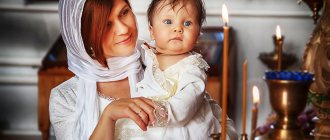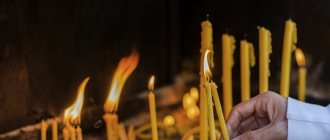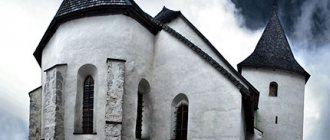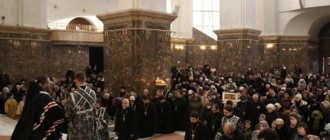» Rituals and rituals » How do Russians perform funeral rites?
0
5583
Article rating
Death is a natural process that every person must go through. In all cultures, there are certain ritual actions aimed at seeing off the deceased. How do Russian funeral ceremonies work? Let's look at the procedure carefully.
Russian funeral ritual
What it is
All nations had certain traditions of saying goodbye to a person. Differences in burial are associated with religious and national customs. The body was given to one of the elements:
- earth (burial in a crypt, grave);
- fire (cremation);
- air (hanging remains);
- water.
Nowadays you can find combined rituals that combine several rituals. The deceased was buried in a natural state or the limbs were bent. Modern traditions favor earthly burial.
In many cultures, death is a transition from one world to another. In order not to disturb the deceased, certain ritual actions must be observed. Some peoples were forbidden to cry and grieve when saying goodbye. Others, on the contrary, needed to show their grief as much as possible.
Christianity has had a huge influence on many cultures. The peculiarity of religion is that it did not completely destroy old customs, but quietly adjusted. Funeral rites in Orthodoxy retain echoes of ancient pagan beliefs.
Which coffins are used to bury those who die from coronavirus?
Rospotrebnadzor continues to develop new methods that would help stop the pandemic. A new version has emerged that a person who died from COVID-19 should not be buried in wooden coffins. This material is not able to protect others from infection with the new Chinese virus. Therefore, it is possible that soon it will be possible to bury only in zinc or glass coffins.
How burial evolved
The traditional ritual is much longer than what happens now. It began from the moment the first signs of death appeared. Knowledge about the sacrament was lost, and modern burial was reduced.
Back in the 19th century, Russian peasants prepared for leaving in advance. It was considered good form if a person made the coffin himself. It is placed in the attic and filled with grain. On the day of the funeral, cereals were poured out to the birds.
The clothes for the last outfit were also sewn ahead of time. There was a special technique that made it possible to create decoration without a single knot or buttons. Women prepared a “dowry” for both themselves and their spouses. All the necessary attributes for death were tied into a bundle.
In the 20th century, an active struggle against Orthodoxy began, so the ritual became as mundane and simplified as possible. The destruction of faith in the afterlife made the ritual boring and lean. The sacred meaning of all actions has disappeared, and what remains is the banal burial of a dead body.
When does the body preparation for funeral begin?
Preparation of the corpse for funeral begins in the morgue, immediately after the autopsy.
This is what they do with the body in the morgue before the funeral:
- Wash off blood, feces and vomit, and urine.
- The stomach is pierced so that gases come out of it, which will cause severe bloating for 2-3 days.
- Place special tampons into all natural orifices of the body. They are treated with special compounds that inhibit decomposition.
- A bactericidal composition is applied to the entire surface of the body to slow down the proliferation of bacteria and worms.
- Fat corpses in the morgue are treated with a special compound that neutralizes unpleasant odors.
- Next, the jaw is fixed by placing a tampon under the tongue.
After carrying out these manipulations, workers begin the finishing touches of preparing the corpse for burial.
Seeing off
A funeral is an event that will happen to every person. If you carry out all the actions according to the rules, it will be easier for the deceased to leave the house. Let's look at the main aspects.
At this stage it is necessary to prepare the body for the sacrament. People who were not related by blood were invited to wash the remains. The deceased is washed with warm water, reading the prayers “Lord, have mercy” or “Trisagion”. Remember that only representatives of the deceased’s gender are suitable for the procedure.
For funerals, Russians usually wear clean, new clothes. You can’t take other people’s clothes, especially relatives. In this case, the deceased will “take” the person with him. Our ancestors were dressed in the best attire. It was customary for single people to dress up as if for a wedding.
The body was laid on the table and covered with a shroud - a white blanket. Before placing the deceased in a coffin, the remains and the “wooden house” were sprinkled with blessed water. A pillow was placed under the head, and a “crown” was placed on the forehead. Remember that your eyes must be closed and your lips closed.
The arms are folded crosswise - the right one is on top of the left one. To secure the limbs, they were tied with special shackles, which were released before burial. They always wore a cross and placed an icon on their chest: for men the Savior, and for women the Mother of God. While the deceased is in the room, a lamp or candle at the head of the house is lit.
Preliminary body preparation
Sanitary treatment of the body of the deceased and his washing are carried out by morgue workers free of charge. If the funeral takes place later than three days later, the relatives of the deceased can order embalming (the body is pricked with various substances for preservation).
How corpses are dressed in the morgue
The bodies in the morgue are dressed according to the wishes and religious preferences of the relatives. Traditional set of things for men:
- shoes;
- underpants;
- shirt;
- socks;
- beautiful suit.
For women it is usually recommended:
- underpants;
- stockings;
- a dress or jacket with a skirt (a neckline on a dress or blouse is unacceptable; items with a high neckline are ideal);
- shoes.
The corpse of a girl who was not married is traditionally buried in a wedding dress and veil.
The deceased's clothing should be 1-2 sizes larger than what he wore during life.
How they do makeup in the morgue
Before applying makeup, a special mask is prepared for the face of the deceased, consisting of the following substances: cologne, alcohol, formaldehyde, glycerin. After preliminary preparation of the face, morgue workers begin applying makeup and other cosmetics.
How to usually make up the dead:
- the skin is heated with a hairdryer (cosmetics do not apply well to cold ones);
- the face is covered with a layer of foundation;
- some areas of the skin are tinted with acrylic paints;
- if it’s a girl, her eyebrows and dimples can be tinted;
- women usually have their lips painted.
The above services for preparing the body for a funeral can be carried out both in the morgue (orderlies and pathologists) and in special funeral homes (make-up artist, hairdresser).
Superstitions while the dead man is at home
Russian funeral rites are densely overgrown with signs. What are the rules of conduct before the coffin is removed from the premises? There are many points that should not be forgotten.
There is a superstition that you should not leave a dead person alone in a room. All items associated with death are a desirable artifact for sorcerers. Those nearby make sure that nothing is missing or put in the coffin.
The open eyes of a dead man were a bad omen. It is believed that the person on whom the gaze falls will soon die. They carefully examine the body, not allowing even the slightest gap between the eyelids.
Old people say that if a deceased person accidentally looks into a mirror, he will be captivated and will no longer be able to leave without the help of a knowledgeable person.
While the coffin is in the room, you cannot sweep it, otherwise you can “sweep out” everyone living in the house. After the remains have been taken to the cemetery, there remains a person who cleans up. To drive out death, they thoroughly wash the floor and throw away the broom, bucket and rag.
The pieces of furniture on which the sarcophagus with the deceased stood are then turned upside down. It can be installed in normal condition only after forty days. To prevent the spirit from disturbing the residents, stools were broken in the villages and burned at the stake.
How and where to receive benefits?
Where the benefit is received depends on which category the deceased falls into.
The benefit is issued:
- at the place of work, if the deceased worked,
- in the pension fund of the Russian Federation, if the deceased is a non-working pensioner,
- at the Social Security Administration, if the deceased was a registered unemployed person,
- through the military registration and enlistment office, if the deceased was a veteran or home front worker of the Second World War.
List of documents required to be submitted to the relevant authorized body.
If a non-working pensioner dies:
- applicant's passport,
- a copy of the deceased's pension certificate,
- medical death certificate,
- certificate of registration of an unemployed deceased pensioner,
- stamp death certificate.
If a registered unemployed person dies:
- applicant's passport,
- medical death certificate,
- certificate of registration of the unemployed or completion of full-time education,
- extract from the house register,
- stamp death certificate.
Takeaway
Traditions at Russian funerals required that the coffin be placed in the center of the room. The funeral service is scheduled between noon and sunset. Any funeral events in the evening are prohibited among Orthodox Christians. The mirrors in the home were covered and the clocks were stopped. Often, towels were hung on the windows, on which the soul rested.
To prevent the deceased from taking any of his relatives, they must be carried out feet first. Our ancestors believed that such manipulation would make the deceased forget the way home. When moving the coffin, you must try not to hit the door or walls with it. In northern Russia, after the deceased left the house, a stone was placed under the corner of the building. Such a talisman protected all loved ones from imminent death.
Removal of the deceased is an important procedure, accompanied by the emotional state of the relatives. Society condemned those who did not cry at funerals or did not grieve enough. At the same time, mothers were forbidden to shed tears for their dead children. It was believed that after death they turned into angels, so it was impossible to be sad.
Among the Slavic peoples, traditions forbade leaving the dead alone. There was always one of our friends, neighbors or acquaintances sitting nearby. It is believed that the soul is very vulnerable in the first three days, so they provided maximum support - they said prayers from the Psalter or invited special readers.
Procession
Funerals in Orthodoxy were treated with great reverence, so the procession was accompanied by the sobs of relatives. At the head was a man who carried a crucifix or icon on a funeral towel. According to church rules, blood relatives and friends are required to carry the coffin with the remains. But superstitions became stronger that the action was trusted exclusively to strangers.
Fears of death remained from pagan times, so they tried not to touch funeral attributes with their hands. The lid and sarcophagus were carried with gloves or on special sheets. In winter they brought them to the cemetery on sleighs. Nowadays hearses perform this mission.
The first person the procession met along the way had to be given bread wrapped in a towel. This ancient ritual symbolized the meeting between the world of the living and the abode of the dead. The “traveler” was obliged to pray for the soul of the deceased.
The procession was forbidden to stop before a cemetery or church. The only exceptions could be places dear to the deceased. It was believed that the more respected the deceased was, the longer the coffin was carried.
Signs of a funeral procession
After the coffin was taken out of the house, there were certain superstitions. If the funeral procession went past the windows, then our ancestors tried to wake up all those sleeping. It was believed that the deceased took with him any person who was asleep.
Orthodox funeral rites prohibited viewing the procession through glass. According to signs, the soul was nearby and could be offended by such uncivilized behavior. The punishment for the impudent person was illness and quick death. The old people advised not to stare out the window and at the dead man, but to look away and make the sign of the cross.
You cannot cross the road before the funeral procession. If a person died from an accident or illness, then the trouble “jumped” to the taboo violator. It is better to wait out the procession on the side than to receive a negative blow to the aura.
When a dead person is taken out of the house, the old people did not advise looking into the windows. A careless movement of the head will attract death to these dwellings. To prevent the relatives of the deceased from dying, you cannot turn back during the procession.
Memorial service
A church service for the deceased was held before burial. It can be done both in the temple and at home. The priest reads prayers and psalms that help calm the soul and adapt it to the new world. The texts figuratively tell about a person’s earthly journey and his life’s ordeals. At the end they mention heavenly conduct and great love for people.
Why is a memorial service needed? When the spirit leaves the body, demons gather around it and try to drag it to hell. It is at this moment that the maximum help of the church is needed, and the action of the ritual facilitates the transition. For three days after death, the soul will be in places where they pray for it.
A secular memorial service is a farewell ceremony at the coffin that precedes burial. The civil ceremony does not carry any religious overtones, although it often takes place in the presence of the priest. There are no serious requirements for the ritual, so it is carried out according to established traditions or the will of the deceased.
Question and answer
What to do when some relatives are against cremation, but it is known for sure that the deceased during his lifetime chose exactly this method of burial and said so?
If his will was expressed in the presence of at least one adult witness, this order must be carried out, regardless of the opinion of some relatives.
At what stage of funeral preparation is it better to call a funeral agent from City Ritual Service LLC?
Service specialists are ready to provide professional assistance at any organizational stage. Many people prudently call our agent immediately after calling emergency services. The arriving employee will provide detailed advice on all issues and will get involved in the funeral preparations already at the stage of collecting documents.
Does City Ritual Service LLC help with funeral preparations at home?
It certainly helps. We have turnkey burial plans for just such options.
Burial
Christian funeral rites are performed until the sun begins to set below the horizon. The pagan belief remains that the daylight takes with it the soul of the deceased. If relatives do not have time to bury the coffin before this period, then one of the relatives will follow the deceased.
When saying goodbye to the deceased, you must kiss the crown of his forehead. You are allowed to cry and lament. The priest says prayers. The lid is nailed down and the body is carefully lowered into the hole. The sacred action is a handful of soil thrown into the grave with the words: “Rest in peace.”
In the pit, the coffin is placed facing east. A cross is installed at the feet, facing west. According to beliefs, the “gaze” of the deceased should fall on a Christian symbol. Ancient traditions required that the grave have only a wooden monument, handmade by relatives. Modern stone slabs do not correspond to popular beliefs.
Sometimes a land redemption ritual was held at the cemetery. Those present took small coins and threw them into the pit. These are fragments of pagan rituals that have survived to our times. Orthodox traditions exclude any non-Christian customs.
When returning from the cemetery, it was important not to bring with you a piece of the world of the dead. The soil was carefully removed from the shoes, and those in contact with the deceased washed in a bathhouse. It is forbidden to invite an orchestra for funerals of Russian Christians. It is forbidden to perform burials on Christmas or Easter.
Difficulties and possible problems
- Imposition of additional services by morgue and cemetery employees and inflated prices.
The guaranteed range of free government services is very modest. There are additional services that are really worth taking advantage of:- makeup and hair styling of the deceased;
— rent of the funeral hall of the morgue for farewell;
— renting a bus to transport relatives and friends of the deceased from the cemetery. As a rule, wreaths, a high-quality coffin, and additional attributes for the coffin are also ordered for an additional fee.
- Errors in the organization of the process. It is necessary to clearly distribute responsibilities - who deals with the documents, who organizes the process at the cemetery, who controls the preparation of the deceased, and so on. The funeral process coordinator must know who is doing what, when, and by what time everything should be ready.
Signs at the cemetery
A grave dug out of size is a sure sign of the death of one of the family members. A lid forgotten at home or mourning wreaths have the same meaning. Remember that the coffin must be nailed up only at the burial site. Death will take not only the person who violated the ban, but also the family of the deceased.
Children and pregnant women were prohibited from attending the funeral. Babies do not have natural energy protection, so a negative attack from evil forces is possible. Women undergoing childbearing could receive severe damage, which would be inherited by the baby. The first person he met was entitled to food “for reference.”
They already enter the cemetery through the gate, and the deceased is taken through the main gate. On the way back you can choose any route. Remember that they don’t walk in front of the dead either. First they carry the coffin, and then the living come up.
When hammering nails into the lid, care must be taken to ensure that the person’s shadow does not fall on the sarcophagus or grave. Old people paid attention that the dead man had no rings, and that the buttons were undone. Before lowering into the pit, be sure to untie the knot holding the fetters together. If you forget to do this, then one of your loved ones will die.
If inner strength pushes a person away from the deceased, then you should not force yourself and kiss the deceased on the crown. The living are often afraid of the dead, so they cannot overcome their fears. By the way, in ancient times it was possible to get rid of fear by simply touching the leg of the deceased.
Wake
According to the rituals, after the burial, a modest table is organized for the hole diggers. Mandatory dishes are kutia, pancakes, and the rest is at the request of relatives. Alcohol was not a necessary product, so its availability was discussed in advance. Bread or cookies were left on the mound for birds, which were considered the souls of the dead.
Funeral services were held on the day of the funeral, 9 and 40 days after death. Our ancestors believed that angels brought the soul of the deceased to the house where they were waiting for it. During this period, it was necessary to go to the cemetery to eat food with the deceased. A little was left at the grave and also distributed to people.
The funeral ceremony brought together relatives, friends and the poor at one table. It was believed that while the spirit travels the earth, it experiences the same needs as the living. A special place was allocated for it under the images and a separate device was installed. A spoonful of kutya was placed on the plate, and the glass with the drink was covered with a piece of bread.
Christian traditions prohibited people from drinking alcohol. Drunk drinking is a relic of pagan funeral feasts. Excess alcohol leads a person to sinful thoughts, preventing the soul of the deceased from moving to another world.
The ceremony cannot be held on weekdays during Lent. The event has been rescheduled for the coming Saturday or Sunday. After the funeral, it was customary to give alms. Now this procedure has been transformed into the ritual of giving cookies and sweets.
What does a morgue look like from the inside?
The inside of the morgue is usually seen only by orderlies, pathologists and funeral directors. Ordinary people are allowed there extremely rarely, so as not to shock the unprepared psyche with what they see.
For those who are interested in what the morgue looks like, it will be enough to read its description provided by the orderlies:
“The first thing that greets a person on the threshold of the morgue is the smell of rotting, mixed with the aromas of formaldehyde, blood, feces and urine. Usually there are empty gurneys along the hall, and the bodies of the dead are in the refrigerator in the corpse storage facility.”
Traditionally, the morgue building houses a department of pathologists. There they establish what the person could have died from and at what time it happened. In the sanitary room, morgue workers rest and have lunch; many have a refrigerator, electric kettle, and microwave there.
In a separate room - a dissection room - the pathologist performs autopsies on corpses. There he has a special table at his disposal, with a built-in drain for liquids, on which he cuts up the bodies of the dead.
Signs after the funeral
The rules state that after the cemetery it was forbidden to go to visit. It was believed that a person carries a particle of death within himself, so tragedy is possible in this house. When leaving the churchyard, the ancestors did not recommend looking back.
During the wake, they place an image of the deceased, and next to him - a glass of drink and bread. Anyone who drinks or eats the food of a dead person will soon die. The same applies to animals. To provide misfortune, the liquid was poured outside the house and the product was buried or burned.
After arriving from the cemetery, people always warmed their hands with a live (open) fire or washed them in hot water. It was customary to light candles and hold limbs over them. The flame burns all the negative energy that is located in places of death.
It is forbidden to grieve or cry heavily at a wake. Ancestors believed that a person goes to a better world, but can drown in the tears of loved ones. You can't get drunk at a funeral dinner. Such a rash act imposes the curse of alcoholism on the family. The first pancake, a spoonful of kutya and jelly are given to the deceased.
Already at home, they pour a glass of water, cover it with bread and sprinkle with salt. The item stands for forty days, after which everything is poured out and buried outside the house. Care should be taken to ensure that no one accidentally spills liquids or takes away food.
Payment amount
In the case of organizing a funeral on a paid basis, the person who has undertaken the obligation to carry out the burial is paid social benefits in an amount equal to the cost of services provided according to the guaranteed list of funeral services, but not exceeding from 02/01/2017 the value of 5,562.25 rubles.
Social benefits must be received within 6 months from the date of death on the basis of a death certificate.
Social guarantees for the burial of citizens living in Moscow and its annexed territories at the time of death in 2017-2018.
| Category of citizens | Benefits for burial | Benefits for the manufacture and installation of a tombstone |
| Non-working pensioners | RUB 16,562.25 | 3,200 rub. |
| Unemployed citizens | RUB 16,562.25 | 3,200 rub. |
| Disabled people of WWII, WWII veterans, home front veterans | RUB 38,400 | RUB 31,541 |
| Combat veterans | RUB 25,269 | RUB 31,541 |
| Veterans of military service | RUB 25,269 | RUB 31,541 |
| Active military personnel | RUB 25,269 | RUB 25,269 |
Meal on the ninth day
Orthodox traditions require relatives to gather at the same table 9 days after death. The ritual passed down from pagan ancestors and became firmly entrenched in Orthodoxy. Why is this ritual needed?
It is believed that from the ninth to the fortieth day the soul wanders through ordeals - obstacles in the form of sins. Good angels act as helpers with evil. Only after passing the “exam” can a person appear before God to receive the final verdict.
The relatives of the deceased create an appropriate atmosphere in the room where the memorial will take place. Allocate a separate place where you can put a glass of water, bread and light a candle. In the morning, a prayer service is ordered in the temple and alms are distributed for the repose.
Not only blood relatives and friends gather at the table, but also colleagues. The more people there are, the easier it is for the soul. According to tradition, no one is invited to the funeral. Only those who consider it important to remember the deceased come. But if they are afraid that someone will forget about the date, then it is allowed to remind them a few days before the event.
Mandatory dishes are compote, kutia or any porridge. They become the link that connects the lost loved one and those around them. Remember that you are not just here to eat. On this day, the best moments in the life of the deceased are remembered.
Techniques for protecting the body from premature decomposition
If the deceased is in the morgue for up to 3 days, there is no need for embalming. But if it is stored for more than 4-5 days, cadaveric spots will appear on the body, a sign of rotting and decomposition.
To stop these processes, conservation techniques are used:
- they inject the body with formaldehyde;
- send it for deep freezing at minus 20 ̊ C (when the shelf life is long enough).
Many manipulations before the funeral are aimed at making the deceased look decent. This will help relatives accept the loss more easily.
Features of forty days
An important ritual concludes the funeral rites. According to beliefs, the soul is still on earth for 40 days after death. During this time, she goes through ordeals and prepares for the transition to another world. The last line after which a person goes to heaven or hell.
Christian customs recommend that loved ones gather together at one table on this day. The funeral ritual is a farewell to the deceased, so it is important to properly prepare for the action. They order a prayer service for the repose in advance and give alms to the poor. In the morning they go to the cemetery with flowers: they light a blessed candle on the grave and leave sweets on the mound.
Remember that an event is not a way to meet relatives or friends. Songs, fun and consumption of alcoholic beverages are prohibited at meals. Kutia and pancakes are obligatory dishes on the table; vegetable salads and fish dishes are allowed. A place is allocated in the house for the deceased, with a glass of water and a piece of bread.
The feast begins with a minute of silence. Each of those gathered says a kind word about the deceased. It is important to restrain emotions and not cry: a loved one is on his last day on earth, so there is no need to overshadow his stay.
Ritual agents and services
Very often, almost simultaneously with the doctors called to recognize the fact of death, funeral service employees arrive. Such ritual agents are often called “black” and openly criticized for high prices and excessive intrusiveness. It's difficult to stay calm immediately after the death of a loved one, but try to be as calm as possible. You are not obligated to agree to an agency employee's proposals just because he has already knocked on your door. Moreover, you can simply not start negotiations with a specialist whom you did not call.
Do you need the help of specialized agencies in organizing a funeral? This is an individual question. Firms working in this area can really take on all the troubles. Only you will have to pay for their services separately. If you want to avoid unnecessary expenses and you have enough strength to do everything yourself, you can do without cooperation with funeral companies. We hope that the instructions for the first steps when a person has died, and the tips for organizing a funeral collected in our article, will help you with this.
Important little things for relatives
Death is a grief for loved ones, which knocks them out of their usual life. This is often used by sorcerers to perform magical rituals. To avoid such mistakes, let's look at the most likely actions.
Nothing should be put in the coffin, especially for other people's things, photographs, money. An object buried in the ground will “call” its owner to follow it. This is a very terrible witchcraft that affects both the owner and the final performer.
A towel is often spread near the sarcophagus. Remember that it is forbidden to step on it: everything connected with the funeral ritual must be lowered into the grave or burned. The exception is consecrated icons. Orthodox traditions prohibit the destruction of shrines, but they cannot be stored at home either. We recommend taking the images to the temple.
Fetters, washing water and hygiene items are the most powerful magical artifacts. Every sorcerer hunts for such things and tries to get them by any means. The ropes are buried along with the coffin, and the liquid is poured far from the house. The comb and soap used to clean the body are left in the grave.
How to transport a body over a long distance?
You can transport a coffin with a body or an urn with ashes. Transportation of the body of the deceased is allowed only in a hermetically sealed zinc coffin. Soldering of zinc coffins is carried out by funeral services upon presentation of:
- death certificate issued by the civil registry office;
- certificates from the Rospotrebnadzor department.
The body must first be embalmed in the morgue. Upon completion of the soldering of the zinc coffin, a specialized funeral service issues a certificate of non-investment (confirms that no foreign objects were inserted into the coffin: drugs, weapons or other things withdrawn from circulation or of limited circulation). This certificate is required for transportation. If necessary, the fact of embalming is also confirmed by an appropriate certificate.
'>certificate on the quality of sealing of the metal lining of the coffin (urn with ashes);
- cremation certificate.
- permission from the embassy or consulate of the destination country;
- certificate of embalming;
- medical report on the cause of death;
- other.
However, to transport a coffin outside the Russian Federation, additional documents may be required:
All documents for transporting a body abroad will need to be translated into the official language of the destination country and notarized.
You can collect the documents yourself or, for an additional fee, contact funeral agents who are directly involved in the transportation of remains.











